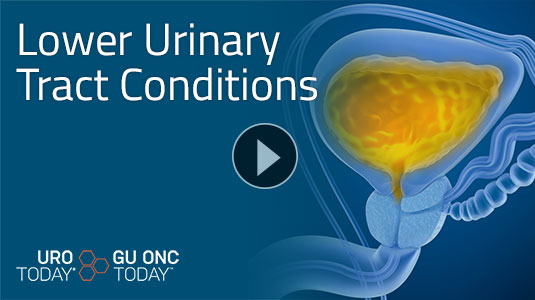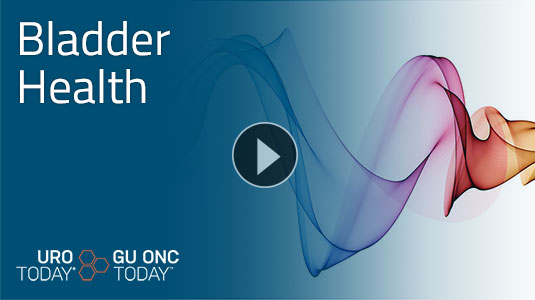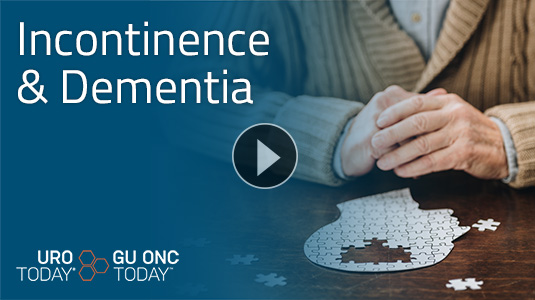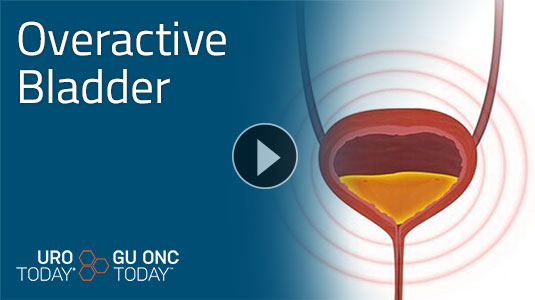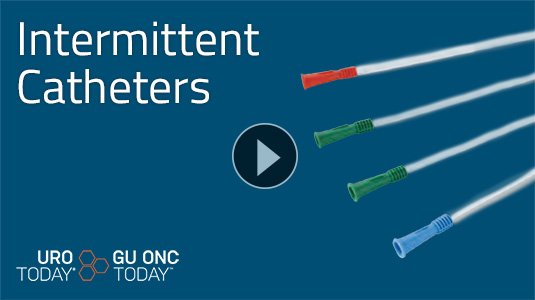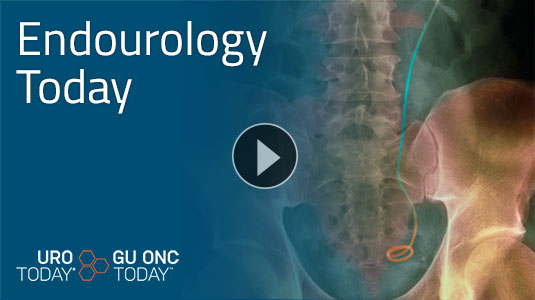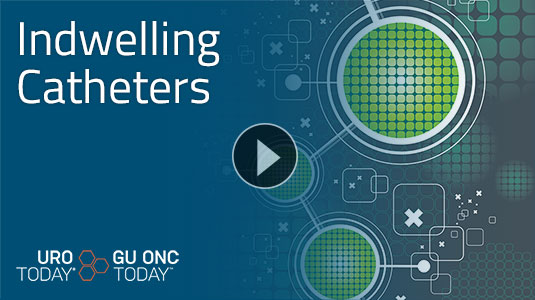AUA 2024: Long-term Dementia Risk with Use of Anticholinergic versus Beta-3-Agonist Pharmacotherapy for Overactive Bladder
Presented by David Sheyn, MD
The 2024 American Urological Association (AUA) annual meeting featured a session on overactive bladder, and a presentation by Dr. David Sheyn discussing long-term dementia risk with the use of anticholinergic versus beta-3-agonist pharmacotherapy for overactive bladder.
Read More
AUA 2024: SOPHIA Study: The New Artificial Urinary Sphincter UroActive™: Results of the First in Man Study at 6 Months Post-Activation
Presented by Emmanuel Chariter-Kastler, MD, PhD
The 2024 American Urological Association (AUA) annual meeting featured a male incontinence session, and a presentation by Dr. Emmanuel Chariter-Kastler discussing the first results of the SOPHIA study using the new artificial urinary sphincter UroActive™.
Read More
ICS 2022: Compliance With Uresta (Cure) Study; A 12 Month Follow-Up Of 40 Women
Presented by Patrick Campbell
This was a UK prospective study of the compliance at 12 months of the use of a vaginal device, the Uresta bladder support, for management of stress urinary incontinence (SUI). Interestingly, study recruitment was through advertisements on social media, running clubs, and gyms. Outcomes were assessed using the PUQ, ICIQ-FLUTS, UDI-6, IIQ-7, QUID, and PGI-I questionnaires.
Read More
ICS 2022: An Open, Single-Arm, Post-Market Clinical Trial Using The Tena Smartcare Change Indicator™ In A Home Environment.
Presented by Piotr Radziszewski
An incontinence absorbent product is changed several times per day, but changing too early leads to unutilized products being discarded, and changing too late implies a risk of urine leakages, as well as, risk of moisture-associated skin damage. Caregivers must check the product for saturation status many times a day, which can be a burdensome manual process. This presentation was on the TENA SmartCare Change Indicator
Read More
ICS 2022: Development Of A Conceptual Framework And Digital Platform For The Selfmanagement Of Interstitial Cystitis: Erica (Remote Engagement With Interstitial Cystitis Aide)
This study reported on the results of an evidence-based digital platform that remotely delivers treatments including self-management strategies to female patients with Interstitial Cystitis/Bladder Pain Syndrome (IC/BPS). The aims were 1) to develop a conceptual framework for the self-management of IC/BPS, 2) to develop a digital platform that remotely delivers first- and second-line AUA treatments of IC/BPS, and 3) to test its feasibility in this population.
Read More
ICS 2022: A Short Story In Proprioceptive Facilitation To The Pelvic Floor – A Proof Of Concept Study Using INNOVO
Proprioception is fundamental to motor learning, and sensorimotor afferents may facilitate changes in motor control. Neuromuscular electrical stimulation (NMES) is used clinically as an adjuvant intervention to facilitate pelvic floor muscle (PFM) contractions. Neural imaging shows that NMES contractions activate similar cortical and subcortical structures to volitional ones. Consequently, these NMES elicited contractions may enhance proprioception and PFM function.
Read More
ICS 2022: The Impact Of Prevalent Overactive Bladder Anticholinergic Use On Cognitive Change In Adults With Normal Cognition, Mild Cognitive Impairment, Or Dementia
Research suggests that OAB anticholinergic medications may lead to cognitive dysfunction and an increased risk of dementia, but few studies have evaluated the effect of these medications in those with pre-existing cognitive dysfunction and few have followed patients long term. APOE-e4 allele is a genetic risk factor for Alzheimer's, and may lead to increased sensitivity to anticholinergic-mediated cognitive decline, but has not been evaluated in the context of OAB anticholinergics.
Read More
ICS 2022: Prospective Multi Center Registry For Patients Undergoing Surgery For Male Stress Urinary Incontinence (Saturn): 1 Year Follow-Up In 500 Patients
Presented by Frank Martens
This presentation reported on data from the initial 500 patients from 20 centers who reached one-year follow-up in the EAU Research Foundation prospective registry SATURN (Surgery for mAle incontinence with artificial Urinary sphincters and slings) which was established to assess the efficacy of male stress urinary incontinence (SUI) surgery in daily practice. SATURN’s overall goal is to analyze 1000 patients undergoing male SUI surgery with 10-year follow-up from 29 implanting centers in 9 European countries. The group has defined “cured” as the absence of pad use or only 1 security pad.
Read More
ICS 2022: Zoom To Scale? Real World Implementation Of Online Versus In-Person Community-Based Continence Promotion
Presented by Madeline Moureau
Mind Over Matter: Healthy Bowels, Healthy Bladder is a small-group behavior change intervention for women aged 50 or older who want to prevent or improve urinary incontinence (UI) or anal incontinence (AI). This is a community-based program that consists of three 2-hour sessions delivered over one month and results of this in-person program have been previously and showed a 9-fold improvement in bladder symptoms and a 4-fold improvement in bowel symptoms compared to controls.
Read More
ICS 2022: A Pressure Sensor Array Can Be Used To Show Maximal Pelvic Floor Muscle Contraction In Different Postures
Presented by Laura Pedofsky
The perineometer, a balloon pressure-type type device, was first described by Dr. Arnold Kegel in the 1940s and since then has been used extensively to determine ‘the strength’ and ‘function’ of the pelvic floor muscles (PFMs). However, due to the design of these devices, the pressure changes reflect global pressure change within the vagina, making it impossible to discriminate between an increase in abdominal pressure and that induced by the PFMs.
Read More
ICS 2022: Effective Pelvic Floor Muscle Exercises In Antenatal Care: Design And Development Of A Training Package For Community Midwives In The United Kingdom
This study aimed to develop a comprehensive training package for midwives and resources for pregnant women, to support the teaching of an antenatal pelvic floor muscle exercise (PFME). The presentation was on the feasibility of such training tested in a pilot randomized controlled trial. The study comprised four iterative phases of intervention development, including a stakeholder event and multiple patients and public involvement and engagement (PPIE) activities. The PPIE advisory group included women with young children, with meetings held in the community.
Read More
ICS 2022: A Randomised Controlled Trial Of The Clinical And Cost‐Effectiveness Of Vaginal Pessary Self‐Management Vs Clinic-Based Care For Pelvic Organ Prolapse
Presented by Suzanne Hagen
A parallel two-arm, superiority, multicentre randomized controlled trial study aim was to determine the effectiveness and cost-effectiveness of self-management of a vaginal pessary on prolapse-specific quality of life (at 18 months) for women with pelvic organ prolapse (POP) when compared to pessary clinic-based care. Inclusion criteria were women age ≥18 years, pessary use of any type/material (excluded: Shelf, Gellhorn, or Cube pessaries), and retention of a pessary for at least two weeks.
Read More
ICS 2022: Efficacy And Safety Of A Novel Gene Therapy (URO-902; PVAX/HSLO) In Female Patients With Overactive Bladder Syndrome And Urgency Urinary Incontinence: Results From A Phase 2a Trial
Presented by Kenneth M. Peters
URO-902 is an intradetrusor injection investigational gene therapy for overactive bladder (OAB). It consists of a plasmid vector that expresses the α subunit of the large-conductance Ca2+-activated K+ channel in the detrusor to reduce bladder hypercontractility. This presentation reported on results from a 12-week interim analysis of a 48-week multicenter, randomized, double-blind, placebo-controlled, dose-escalation phase 2a trial assessing the safety and efficacy.
Read More
ICS 2022: Long-Term Results Of App-Based Self-Management Of Urgency And Mixed Urinary Incontinence In Women
Presented by Towe Wadensten
Delivering behavioral interventions, specifically pelvic floor muscle training (PFMT), via a mobile app has exploded over the past few years. The Tät®II, a popular mobile app includes PFMT, bladder training, psycho-education, lifestyle advice, an exercise log, reminders, reinforcement messages, and tailored advice. In a 15-week randomized controlled trial (RCT), this app was shown to be effective for the self-management of urgency urinary incontinence (UUI), and mixed urinary incontinence (MUI).
Read More
SUFU 2022: Trends in Overactive Bladder Therapy Utilization: An Evaluation of the Impact of Clinical Care Pathways and Practice Guidelines
Presented by Claire S. Burton, Amy Zhang, Alayne Markland, Ekene Enemchukwu
(UroToday.com) Evidence-based treatments are available for overactive bladder (OAB) with published guidelines and treatment pathways created for clinicians to optimize treatment and provide a clinical framework for diagnosis and treatment. The impact of these efforts remains unclear and medical treatment pathways are poorly understood.
Read More
SUFU 2022: Bladder Hotline: The Impact of COVID-19 and Telemedicine on Empiric UTI Treatment in Women
Presented by Madeline J. Epsten, Jennifer Ferraro, Fareesa Khan, Cynthia Brincat, Kristin M. Jacobs
(UroToday.com) The effects of the COVID-19 pandemic and telemedicine on urinary tract infection (UTI) treatment are largely unknown. This study evaluated the impact of COVID-19 and telemedicine on empiric UTI treatment in women, hypothesizing that increased use of telemedicine during the pandemic would increase the rate of empiric UTI treatment.
Read More
SUFU 2022: The Bladder Inhibitory Effects of Saphenous Nerve Stimulation are Mediated Via A Supraspinal Pathway in Anesthetized Rodents
Presented by Grant Gruenspan, Jian Wang, Laureen Hachem, Michael Fehlings, Paul Yoo
(UroToday.com) Peripheral nerve stimulation techniques are emerging as an effective alternative to existing therapies for overactive bladder (OAB). As a novel approach, saphenous nerve (SAFN) stimulation is being investigated as a method of electrically modulating bladder function. Published work showed that SAFN stimulation in urethane-anesthetized rats
Read More
SUFU 2022: A Closer Look: Outcomes of Intradetrusor Injection of OnabotulinumtoxinA (BTX-A) in the Elderly Population.
Presented by Natalia Hernandez, Lia Miceli, Julie N. Stewart, Ricardo R. Gonzalez, Rose Khavari
(UroToday.com) The AUA guidelines recommend oral anticholinergics/antimuscarinics and beta-3 adrenergic agonists as second line therapy. There is increasing understanding that oral anticholinergics/antimuscarinics may have been negative cognitive effects and one of the beta-3 adrenergic agonists (mirabegron) may negatively affect the blood pressure in older adults.
Read More
SUFU 2022: Urinary Tract Infection on Social Media: Examining YouTube Content As a Source of Patient Educational Information
Presented by Zhenyue Huang, Rosen Jeong, Edwin Lee, Heng Ruan, Tal Meir Cohen, Jason Kim
(UroToday.com) The rising presence of social media has offered a wide array of publicly available medical information for women suffering from recurrent urinary tract infections (rUTIs). This study sought to investigate the quality of information for UTI on YouTube.
Read More
SUFU 2022: Patient Preference of Third Line Therapy for Overactive Bladder
Presented by Anjali Kapur, MD, Tal Cohen, MD, Colin Dabrowski, MD, Rebecca Andersen, MD, Kuemin Hwang, BS, Edwin Lee, BS, Heng Ruan, BA, Steven Weissbart, MD, Jason Kim, MD
(UroToday.com) Third-line therapies, including intradetrusor onabotulinumtoxinA (Botox), percutaneous tibial nerve stimulation (PTNS), and sacral neuromodulation (SNM), are indicated for patients with overactive bladder (OAB) who are refractory to first- and second-line therapies. This study sought to investigate specific reasons for patient preference of each third-line OAB therapy.
Read More
SUFU 2022: D-Mannose Intake in the Diet of Women with Recurrent Urinary Tract Infections May Affect Urinary ph and Contribute to its Preventive Effectiveness
Presented by Juliann Chavez, Jacqueline Chavez, Ethan Fan, Alana Christie, Philippe Zimmern
(UroToday.com) D-mannose is a bioactive monosaccharide frequently recommended by clinicians to prevent recurrent urinary tract infections (rUTIs) in women. It is unknown if this protective effect against RUTIs results from urinary pH changes. This study analyzed the effect of D-mannose on urinary pH.
Read More
SUFU 2022: Use of Cranberry Supplement, D-Mannose, and other OTC Modalities for Prevention of Recurrent UTI in Women Post-Electrofulguration
Presented by Parker Kenee, Alana Christie, Philippe Zimmern
(UroToday.com) In women with antibiotic-recalcitrant recurrent urinary tract infections (RUTI), electrofulguration (EF) to destroy of areas of chronic cystitis can provide durable cure or improvement. However, some women will fail while others will experience some UTI recurrences over time and are interested in non-antibiotic therapies to combat these UTI episodes.
Read More
SUFU 2022: "I Just Need to Know I'm Not Alone”: A Qualitative Analysis of Reddit Discourse on Recurrent Uncomplicated Urinary Tract Infections
Presented by Zara Khan, Parker R.M. Kenee, Shanee Abouzaglo, Jennifer Foster, Jordan McCoy, Naeemul Hassan, PhD, Philippe E. Zimmern, MD, Rena D. Malik, MD
(UroToday.com) The aim of this qualitative study was to qualitatively analyze rUTI discourse on the website Reddit and identify areas that healthcare professionals may better address to improve care for women with rUTI. The authors queried public subreddits r/TwoXChromosomes, r/Askwomen, r/WomensHealth, and r/CUTI for combinations of the search terms “recurrent” or “chronic”
Read More
SUFU 2022: A 3D Digital Map of the Human Saphenous Nerve: A Neuroanatomical Approach to Developing A Novel Neuromodulation Therapy for Treating Overactive Bladder
Presented by Michael Peng, Paul Yoo, Anne Agur
(UroToday.com) Saphenous nerve (SAFN) stimulation is an emerging treatment for overactive bladder (OAB) syndrome, but precise knowledge of the subcutaneous distribution of nerve branches is lacking. This study volumetrically documented and modeled in 3D the course of branches of the SAFN relative to bony/soft tissue landmarks.
Read More
SUFU 2022: Efficacy of Antimicrobial Intravesical Treatment for Uncomplicated Recurrent Urinary Tract Infections: A Systematic Review
Presented by Meghana Reddy, Philippe Zimmern
(UroToday.com) Intravesical antimicrobials (IVA) can provide a localized modality of treatment for uncomplicated recurrent urinary tract infections (rUTIs). This was a systematic review on the efficacy of IVA in the management of rUTIs. The review included articles from inception to April 2021, utilizing the Cochrane and PRISMA standards with the following databases:
Read More
SUFU 2022: Identifying Navigator Impact on Utilization of Onabotulinumtoxina as a 3rd Line Treatment in Overactive Bladder: A Retrospective Database Study in the United States
Presented by Raveen Syan, Jennifer Miles-Thomas, Diane K. Newman, Nitya Abraham, Keely Madaj, Krystal Anson Spenta, Amin Boroujerdi, Zhanying Bai, Lei Luo, Ekene Enemchukwu
(UroToday.com) Only 10% of patients with OAB progress to third line options (onabotulinumtoxinA [onabotA] and neuromodulation). Reasons include a lack of understanding of options, fear of side effects, or desire to avoid invasive treatments. Using a navigator, defined as a healthcare professional focused on patient-centered care),
Read More
SUFU 2022: The Use of D-Mannose in the Prevention of Recurrent Urinary Tract Infections
Presented by Alixandra Ryan, Hayden Hill, MD, Anastasia Couvaras, MD, Colin Goudelocke, MD
(UroToday.com) Current guidelines recommend antibiotic treatment, and in some cases, antibiotic prophylaxis. The possible adverse effects, cost, and increased bacterial resistance to prophylactic antibiotics have led to the study of alternative prevention, such as cranberry, probiotics, and D-mannose. D-mannose is a monosaccharide isomer of glucose rapidly absorbed when given orally and
Read More
SUFU 2022: Assessing the Utilization of the Healthcare System
Presented by Elisabeth Sebesta, Stephanie Gleicher, Melissa Kaufman, Roger Dmochowski, W. Stuart Reynolds
(UroToday.com) This study sought to assess the proportion of patients who sought out medical care and received treatment for bladder symptoms, in addition to any predictive factors for doing so. A sample of 3,396 adults was recruited electronically to complete a questionnaire on clinical and demographic information, social needs, and urinary symptoms (LURN SI-10, ICIQ-UI SF, and PPBC).
Read More
SUFU 2022: Efficacy of Antibiotic Prophylaxis Among Intermittent Catheter Users with Different Neurologic Diseases: A Secondary Analysis of the AnTIC Trial
Presented by Blayne Welk, Holly Fisher, Thomas Chadwick, Chris Harding
(UroToday.com) This study was a secondary analysis of community dwelling participants to assess the relative reduction in UTIs among people with different neurologic diseases and intermittent catheter use and to determine if UTIs impacted renal function. Analyzed were those individuals who participated in a 12-month randomized trial (AnTIC, a multicentered
Read More
SUFU 2022: Incidence of Urinary Tract Infections Between Neurogenic and Non-Neurogenic Bladder Dysfunction Patients Performing Intermittent Catheterization - An Analysis of Marketscan Data
Presented by Blayne Welk, Sara Lenherr, Yasir Santiago-Lastra, Melanie Goodman Keiser, Holly Norman, Christopher Elliott
(UroToday.com) This study compares UTI incidence and severity among intermittent catheter (IC) users with neurogenic (NLUTD) and non-neurogenic diagnoses. Analysis of health insurance claims data from the IBM MarketScan Database (commercial Preferred-Provider Organization and Medicare supplemental claims) between January 1, 2015 – December 31, 2019
Read More
SUFU 2021: Evaluating the Association of Frailty and Racial and Socioeconomic Disparities on Postoperative Complications Among Patients Undergoing Apical Pelvic Organ Prolapse Surgery
Presented by Sirpi Nackeeran
The study’s aim was to show how frailty affects perioperative complications in women undergoing pelvic organ prolapse (POP) surgery. They sought to determine (1) the role of frailty on postoperative complications and (2) the association of racial and socioeconomic differences between frailty and postoperative complications among women undergoing apical prolapse repair.
Read More
SUFU 2021: Recurrent Urinary Tract Infection: Fact or Fiction
Presented by Duane Hickling, MD
Dr. Duane Hickling presented the evidence behind many common urinary tract infections (UTI) treatments: water, methenamine salts, D-Mannose, and lactobacillus. He noted that UTIs are common as 20% of college-aged women had at least one culture-confirmed UTI recurrence within 6 months.
Read More
SUFU 2021: “Say Hello to My Little Friends”: How We Use the Microbiome in Clinical Urology
Presented by A Lenore Ackerman, MD Ph.D.
A urinary tract infection (UTI) is defined as microbial infiltration of the normally sterile urinary tract. But there are no accepted definitions of UTI-associated symptoms, cut-offs for culture result, or definitively accepted uropathogens that can guide clinicians in the objective management of a UTI.
Read More
SUFU 2021: Bulkamid®, Periurethral Injection for the Treatment of SUI Due to Intrinsic Sphincter Deficiency
Presented by Eric Rovner, MD
Dr Rovner moderated a symposium on Bulkamid, a periurethral injection which was approved by the FDA in 2020 for the treatment of stress urinary incontinence (SUI) due to intrinsic sphincter deficiency (ISD) or in women who have SUI or stress predominant mixed urinary incontinence (UI).
Read More
SUFU 2021: SUFU Lifetime Achievement Award
Dr Tamara Bavendam was given the SUFU Lifetime Achievement award in recognition of an outstanding career in urology. She had previously received SUFU’s Distinguished Service award. In accepting the reward, Dr. Bavendam reflected on what she termed “my unusual career”.
Read More
SUFU 2019: An Update on Nocturia - What's Keeping You Up at Night?
Presented by Jeffrey P. Weiss, MD
Miami, FL (UroToday.com) Dr. Jeffrey Weiss provided an update of the management of nocturia. Patients are oftentimes asked to fill out a 24-hour voiding diary but compliance in completing them is sometimes very difficult to obtain.
Read More
SUFU 2019: The Impact of the New Guidelines on the Management of BPH in 2019
Presented by Harris Emilio Foster, MD
Miami, FL (UroToday.com) Dr. Foster leads the audience through the AUA BPH Guidelines briefly emphasizing the new changes /updates that will be seen in the new updated BPH guidelines.
Read More
ICS 2018: Contemporary Outcomes of Surgery for Bladder Pain Syndrome/Interstital Cystitis
Presented by Alison P Downey, MD
Philadelphia, PA (UroToday.com) Dr. Chapple from Royal Hallamshire Hospital, Sheffield, and his colleagues presented their experience and outcome of surgical intervention in the management of bladder pain syndrome in a tertiary center.
Read More
ICS 2018: An Overview in Urodynamics Procedures
Presented by Mikel Gray, Ph.D., RN
Philadelphia, PA (UroToday.com) Mikel Gray, Ph.D., RN provided an overview of urodynamic procedures, which were defined as a set of tests created to estimate storage and evacuation of urine from the lower urinary tract (LUT).
Read More
ICS 2018: Preventing Catheter-Associated UTIs: US Perspective
Presented by Shannon Novosad, MD, MPH
Philadelphia, PA (UroToday.com) Shannon Novosad, MD, medical officer at the Centers for Disease Control and Prevention (CDC) has opened Educational Course on Clinical Directions in Continence care by providing an overview
Read More




